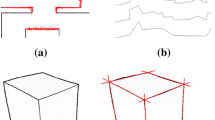Abstract
A new approach for the rapid and robust surface reconstruction from a point cloud is presented based on the distance field and the least-squares projection (LSP) algorithm. This novel approach works directly on the point cloud without any explicit or implicit surface reconstruction procedure. First, a coarse base polygonal model was created directly from the distance field for the given point cloud through the iso-surface extraction. After acquiring a rough base polygonal model, we obtain a quality polygonal model through the iterative refinement and least-squares projection which projects current working polygonal model onto the point cloud in a least-squares sense. The main contribution of this work is the robust and fast surface reconstruction from randomly scattered 3D points only without any further information. We demonstrate the validity and efficiency of this new approach through a number of application examples.
Similar content being viewed by others
References
Lee, I. K., “Curve reconstruction from unorganized points,” Computer Aided Geometric Design, Vol. 17, No. 2, pp. 161–177, 2000.
Pauly, M., Gross, M. and Kobbelt, L., “Efficient simplification of point-sampled surfaces,” Proceedings of IEEE Visualization’ 02, pp. 163–170, 2002.
Kobbelt, L. and Botsch, M., “A survey of point-based techniques in computer graphics,” Computers and Graphics, Vol. 28, No. 6, pp. 801–814, 2004.
Azariadis, P., “Parameterization of clouds of unorganized points using dynamic base surfaces,” Computer-Aided Design, Vol. 36, No. 7, pp. 607–623, 2004.
Amenta, N., Choi, S. and Kolluri, R., “The power crust,” Proceedings of the sixth ACM Symposium on Solid modeling and applications, pp. 249–266, 2001.
Whitaker, R., “A level-set approach to 3D reconstruction from range data,” International Journal of Computer Vision, Vol. 29, No. 3, pp. 203–231, 1998.
Zhao, H., Osher, S. and Fedkiw, R., “Fast surface reconstruction using the level set method,” 1st IEEE Workshop on Variational and Level Set Methods, pp. 194–202, 2001.
Muraki, S., “Volumetric shape description of range data using blobby model,” ACM SIGGRAPH Computer Graphics, Vol. 25, No. 4, pp. 227–235, 1991.
Carr, J. C., Beatson, R. K., Cherrie, J. B., Mitchell, T. J., Fright, W. R., McCallum, B. C. and Evans, T. R., “Reconstruction and representation of 3D objects with radial basis functions,” Proceedings of SIGGRAPH’ 01, pp. 67–76, 2001.
Kojekine, N., Hagiwara, I. and Savchenko, V., “Software tools using CSRBFs for processing scattered data,” Computers and Graphics, Vol. 27, No. 2, pp. 311–319, 2003.
Ohtake, Y., Belyaev, A., Alexa, M., Turk, G. and Seidel, H. P., “Multi-level partition of unity implicits,” ACM Transactions on Graphics, Vol. 22, No. 3, pp. 463–470, 2003.
Yoo, D. J., “Filling Holes in Large Polygonal models Using an Implicit Surface Scheme and the Domain Decomposition Method,” Int. J. Precis. Eng. Manuf., Vol. 8, No. 1, pp. 3–10, 2007.
Liu, Y. S., Paul, J. C., Yang, J. H., Yu, P. Q., Zhang, H., Sun, J. G. and Ramani, K., “Automatic least-squares projection of points onto point clouds with applications in reverse engineering,” Computer-Aided Design, Vol. 38, No. 12, pp. 1251–1263, 2006.
Hoppe, H., DeRose, T. and Duchamp, T., “Surface Reconstruction from Unorganized Points,” Proceedings of SIGGRAPH’ 92, pp. 71–78, 1992.
Lange, C. and Polthier, K., “Anisotropic smoothing of point sets,” Computer Aided Geometric Design, Vol. 17, No. 2, pp. 161–177, 2000.
Ou, Y. D. and Feng, H. Y., “On the normal vector estimation for point cloud data from smooth surfaces,” Computer-Aided Design, Vol. 37, No. 10, pp. 1071–1079, 2005.
Barentzen, J. A. and Aanas, H., “Signed distance computation using the angle weighted pseudo-normal,” Transactions on Visualization and Computer Graphics, Vol. 11, No. 3, pp. 243–253, 2005.
Gueziec, A., “Meshsweeper: Dynamic point-to-polygonal mesh distance and applications,” IEEE Transactions on Visualization and Computer Graphics, Vol. 7, No. 1, pp. 47–60, 2001.
Sud, A., Otaduy, M. A. and Manocha, D., “DiFi: Fast 3D distance field computation using graphics hardware,” Proc. of Euro-graphics, Vol. 23, No. 3, pp. 557–566, 2004.
Frisken, S. F., Perry, R. N., Rockwood, A. P. and Jones, T. R., “Adaptively sampled distance fields: a general representation of shape for computer graphics,” Proceedings of SIGGRAPH’ 00, pp. 249–254, 2000.
Huang, J., Li, Y., Crawfis, R., Lu, S. C. and Liou, S. Y., “A complete distance field representation,” Proceedings of Visualization’ 01, pp. 247–254, 2001.
Yoo, D. J., “A Study on Filling Holes of the Polygonal model using Implicit Surface Scheme,” Journal of the Korean Society for Precision Engineering, Vol. 22, No. 3, pp. 107–114, 2005.
Yang, X. N. and Wang, G. Z., “Planar point set fairing and fitting by arc splines,” Computer-Aided Design, Vol. 33, No. 1, pp. 35–43, 2001.
Hu, G., Peng, Q. and Forrest, A. R., “Mean shift denoising of point-sampled surfaces,” Visual Computation, Vol. 22, No. 3, pp. 147–157, 2006.
Schall, O., Belyaev, A. and Seidel, H. P., “Robust filtering of noisy scattered point data,” Proceedings of Eurographics Symposium on Point-Based Graphics, pp. 71–77, 2005.
Yoo, D. J. and Kwon, H. H., “Shape Reconstruction, Shape Manipulation, and Direct Generation of Input Data from Point Clouds for Rapid Prototyping,” Int. J. Precis. Eng. Manuf., Vol. 10, No. 1, pp. 103–113, 2009.
Yoo, D. J., “Three-dimensional Morphing of Similar Shapes Using a Template Mesh,” Int. J. Precis. Eng. Manuf., Vol. 10, No. 1, pp. 55–66, 2009.
Yoo, D. J., “General 3D Offsetting of a Triangular Net Using an Implicit Function and the Distance Fields,” Int. J. Precis. Eng. Manuf., Vol. 10, No. 4, pp. 131–142, 2009.
Author information
Authors and Affiliations
Corresponding author
Rights and permissions
About this article
Cite this article
Yoo, DJ. Rapid surface reconstruction from a point cloud using the least-squares projection. Int. J. Precis. Eng. Manuf. 11, 273–283 (2010). https://doi.org/10.1007/s12541-010-0031-2
Received:
Accepted:
Published:
Issue Date:
DOI: https://doi.org/10.1007/s12541-010-0031-2




